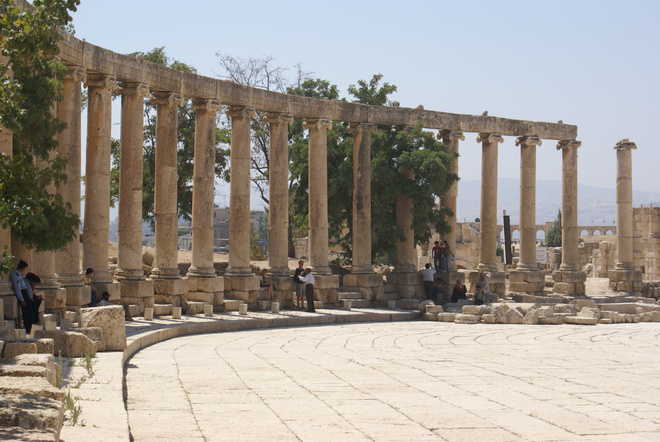
From pillar to pillar: The Oval Plaza
Hugh & Colleen Gantzer
Colonials always long for home. In the Himalayas, the Brits discovered our shepherds’ grazing grounds, dotted with the mansoor scrub, converted it into our hill-station of Mussoorie. It had a carefully cultivated, English countrified air about it. In Jordan, 2,000 years ago, the Romans changed an Arabian town into a Romanesque Mediterranean centre with public baths, fountains, colonnaded streets, and theatres with VIP seats. They also changed its name from Garshu to Gerasa. It is now known as Jerash.
We drove the 48 km from Jordan’s capital, to Jerash. We parked in a lot above the Wadi Jerash stream and strode up an inclined road, got a glimpse of the modern town massed below, and stepped into AD 50. This is, reputedly, ‘the world’s best preserved Roman provincial city’, designed by skilled Roman architects and engineers.
Visually, the most impressive space is the Oval Plaza ringed by a colonnade of Ionic pillars. It was the equivalent of Delhi’s Jantar Mantar and Mumbai’s Oval. Presumably, this was also the place where disgruntled citizens growled at the exorbitant price of Indian textiles and their moral police agitated against hi-society Roman women who flaunted these see-through fabrics.
Stretching out from the Oval Plaza is the impressive Colonnaded Street. Broad pavements once held shops and we noticed stone manholes to drain water into underground sewers. Presumably, there were no flooded roads in Jerash.
Halfway up this road, the columns become broader. This was the entrance to the Macellum, a covered shopping area. The British could have had replicated this idea when they created Connaught Place in New Delhi. The columns of Connaught Place, however, are not crowned by decorative capitals. Lying around the ruins of Jerash were acanthus capitals carved with the stylised leaves of a prickly desert shrub growing wild in the Mediterranean lands.
The Roman obsessions with columns and commemorative arches, appeared in Jerash’s soaring Hadrian’s Arch, honouring the visit of the Emperor Hadrian in AD 129. It was meant to be the southern gate but the civic authorities lost their incentive when the Emperor died.
No town worth its name can do without its sports arena. This is the safety valve of the commoners and distracts their attention from bad governance, corruption and the other ailments of a top-down society. Jerash had its Hippodrome. This enormous arena could hold 15,000 frenzied spectators, as the charioteers raced around, whipping their steeds, making and breaking fortunes in this major, and very prosperous, trading town. We walked past the massive City Walls and through the South Gate. The space in front was empty but when the city was at the height of its fame, this was the open market square where owners of push-carts and canopied stalls offered bargains from all over the world, including muslin and spices from India.
Then we came to a monument that must have been very appealing in its time: the Nymphaeum. This beautiful fountain, with its red bowl, was dedicated to those graceful, semi-divine women, the nymphs. Civic fountains in cities around the world are generally part of the cultural legacy of Rome inherited by the British. Sadly, that other monument to the Roman obsession with water, the West Baths, collapsed in the great earthquake of January AD 749 and was never rebuilt.
For some strange reason, neither the North nor the South Theatre seemed to have been damaged by that seismic disturbance. The North Theatre was smaller and could have been used for civic meetings and not only for theatre. The South Theatre’s stage has been reconstructed and the acoustics are still superb as we heard when a bagpiper and drummer, in Bedou robes, filled the air with their music. Even in those distant days some people were more equal than others: the best seats in the theatre were reserved, and Greek letters were inscribed on these to make sure that others did not occupy those VIP places.
That was many centuries ago in Jordan’s Jerash. Clearly, the more things change, the more they remain the same.



























